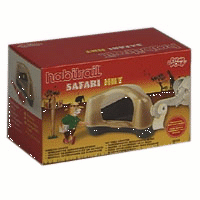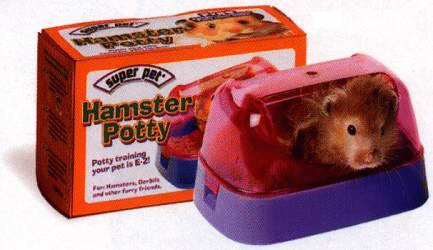
Potty Training your hamster

Potty Training your hamster
[Home|Care guide|Housing your hamster]

Potty Training your hamster
[Home|Care guide|Housing your hamster]

However, there is a way to get that well-known 'smelly' hamster cage to be less smelly generally. Beleive it or not, hamsters can train themselves to use a litter box. Every modern hamster home should have one. Only a couple of hamster 'potties' are on the market, but some can also be made (see "Make your own").
Potties
Habitrail is a good example of a company who sells hamster potties. These triangular shaped plastic products usually come with litter, or some stores let you buy expensive habitrail litter. I've found that cat litter works just as good. Some kinds of 'potties' are square too (see picture at bottom). Potties cost about $5.00, and are generally worth it. When looking for one, look for a well-ventalated, chew-proof, and easy to clean module. To buy a hamster potty for $4.05 (not including shipping and handling), click the picture.
The point:
So, in short, to have a modern hamster home, it needs to be equipped with a well-ventalated hamster potty. With it, you also need clumping litter (cat litter will do fine), and a scoop. Most hamster-potties come with a conveinient, hamster-sized scoop. However, if you don't have one, a plastic fork will suffice.

The major problem you might come up against is nesting in the litter box. I can't help you much there. Just try to give alternate living quarters. Boxes, tunnels... little plastic houses for habitrail and sam cages. Putting treats, bedding, and soft material in them might help.
If you have any other problems, please E-mail me and I will answer as best I can.
Placement
Placement is very important for a hamster potty. Most hamsters 'go' in the corner nearest their water bottle-or so I have noticed. They usually also groom themselves there. This is obviously a good choice of placement. However, you should put it wherever your hamster usually urinates without it. It might help to pick up some little hamster-poops (eww! yuckie gross) and put them in the litter box for starters.
Make your own
Making your own hamster potty is easy and inexpensive. An empy small, plastic container will do fine. Cut a wide opening in the side about an inch above it's floor (so if the hamster digs in the litter, it wont fly out as easily). If possible, cut a hole in the ceiling of the container (for ventalation, and to discourage the hamster to sleep in it etc). Use cat litter (or hamster litter) and cover the floor of the containter with it. Use a fork (plastic works best) to clean out the litter once every day or every other day. See Cleaning.
Cleaning
For litter, you can buy hamster litter or finely-grained, clumping hamster litter (scented or no, but it may matter to your hamster). Every day or every-other day the soiled litter should be scooped out with a scoop. If you don't have a scoop, a fork will do (plastic works best). When you clean out the hamsters cage, dump out the un-used litter and scrub the bottom of the potty. Then dry it, and put in fresh litter.

